Right off the bat, McCloud gives the reader strong examples of how our focus on the frame and the properties it holds helps the viewer fill in blanks and create a sense of time when reading multiple parts of dialogue in a single frame. Time doesn’t stay consistent specifically based on singular properties of a frame. Rather, it is comprised of the sizing of the frame, how much dialogue, what is being captured in the frame, and even the detailing often having the audience spend more time looking at the quality of the art to imply impact.
Take for example the first example McCloud gives that involves a wide spread of characters speaking but there is a series of events and timing that helps create a sense of flow. Starting on the left the man takes a picture, the guy who gets his picture taken reacts, due to that reaction a women discourages the picture taker, then another women responds to her saying that he is fine doing so, then a man responds to the fact that he is being encouraged and encourages other behavior, and lastly the man on the right acknowledges his remarks and encourages as well.
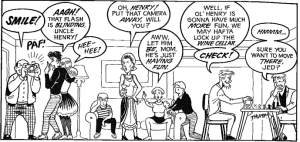
When first looking at this scene, my first initial thought is that all of these pieces of dialogue happen at the same time, because visually they ARE being presented at the same time. But it’s because of the content of what they are saying and who they are speaking to that creates a order of operations rather than a chaotic “everyone is speaking at the same time.” So now we have gotten a sense of space where everyone is and established interactions with one another as a quick judge of character. What was done in one frame is a shot that would most likely last around 15-20 seconds panning from character to character as the audience focuses on the next person.
The best connection that McCloud makes is how the rope being stranded from one dialogue bubble to the next. We can see that the flow of the events have to happen in a certain order otherwise the dialogue they provide wouldn’t match up with a different character such as one character saying “Oh Henry, put that camera away will you?” and the next saying “hmmmm, you sure you want to move there Jed?” It just doesn’t make sense!
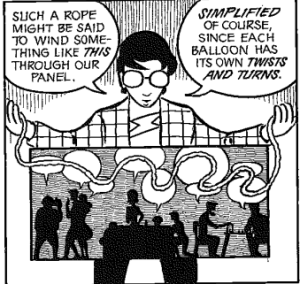
The other point McCloud made that stuck out to me is the frame shaping and its placement with the other frames. We in our culture read from left to right top to bottom so following this flow is pretty important, but that doesn’t mean we are completely restricted to this or how these frame are expressed individually or in a sequence. Some frames use 2 frames overlayed to often emphasis a certain aspect of a frame such as a zoom in or extra dialogue that happens within the same scene. These overlay frames can be place almost anywhere overtop as long as the writer can express what is happening in the background frame in relation to the one overtop.
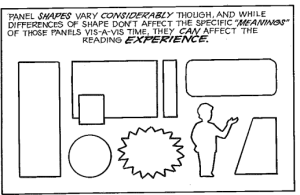
Last point I want to talk about is panel sizing and framing within the shot size. Frame sizing often implies stronger importance on frames that are bigger when there are more details or aspects that the author wants the reader to pick up on. This is best explained in the “I guess” comic McCloud refers to, as it helps us create a sense of time between first dialogue and the next. Looking at the 2 examples below:
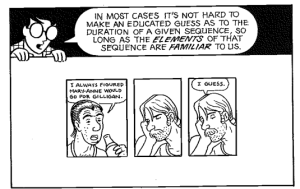
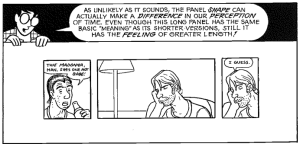
The first example shows a moment of thought, its brief but still exists within the timeline. But look at the size and framing of the second example, it shows deeper more well thought out thinking, they even make him a bit smaller in the scene so that both himself and the shot have gained new perspective. Not to mention that the frame zooming back in also creates a sense of impact to admitting the “I guess” to show that he put more thought into it verses the first example.
-Rylan Eisenhauer
consider the framed panel in a comic as a cinema shot. Wider or longer panels are like shots with longer durations (“long takes”). Smaller panels are like shots of shorter durations. Discuss some aspect of McCloud’s visual essay that makes you think of the possibilities of time manipulation in digital cinema or of a certain movie scene that plays with time.